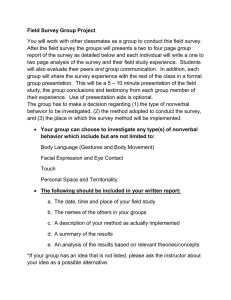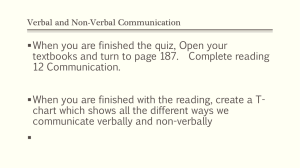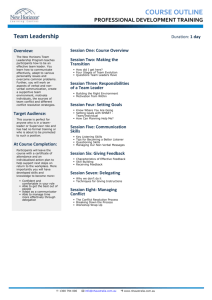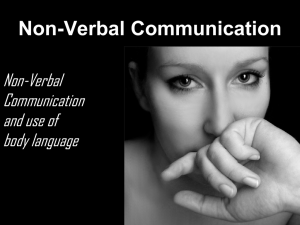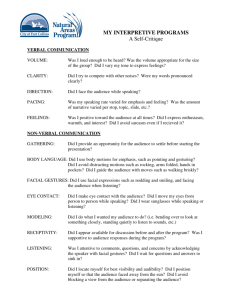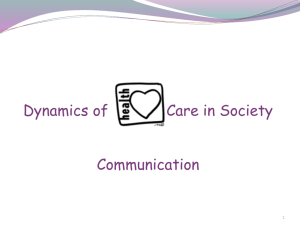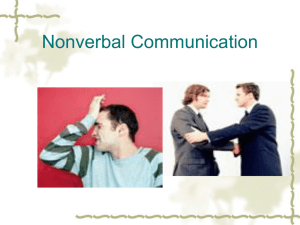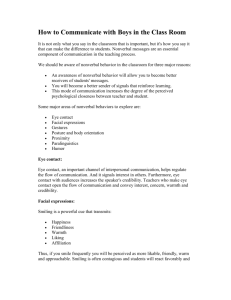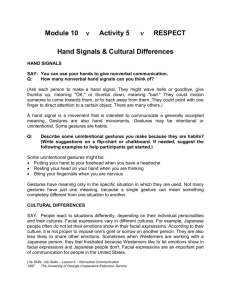Slides from the presentation - Conflict Resolution Network
advertisement
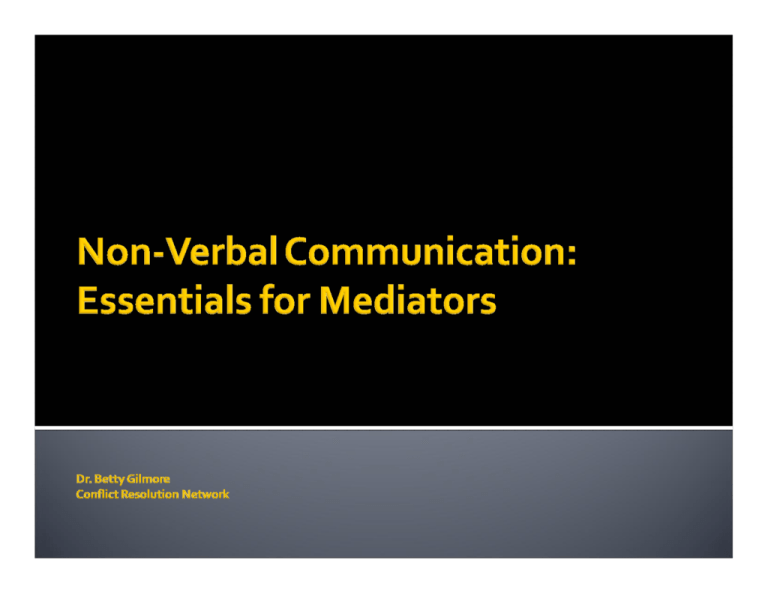
“No words are so clear as the language of body expression once one has learned to read it” ~Alexander Lohen Nonverbal Behavior: Any wide variety of human behaviors that also have the potential for forming communicative messages. Nonverbal Communication: Communication without words. Occurs almost always in the context of verbal behavior. Nonverbal behavior becomes communication when someone interprets it. Non-verbal messages are more believable than verbal communication Non-verbal messages are critical to successful relationships Non-verbal messages not only communicate attitudes and how a person is feeling, but how they are coping During a 30 minute negotiation, both parties transmit a total of 800 body signals Non-verbal communication innate, learned, and is culturally specific Infants The human face exhibits six primary emotions (happiness, sadness, surprise, fear, anger, and disgust/contempt) At the age of 12, children learn most of adult nonverbal norms and accept the nonverbal over the verbal messages We learn facial management techniques early in life The most significant source of emotional information is the face, which can channel as much as 55% of our meaning. Vocal cues convey another 38% of our emotional meaning. We communicate approximately 93% of emotional meaning nonverbally. Complementing Contradicting Accenting Repeating Regulating Substituting Definition: Non-verbal behavior related to movement, either of any part of the body or the body as a whole Gestures and movement Body language Facial Expressions, eye behavior **Communicate information about disputant’s attitude and power relations Generally in western societies: Open limb positions-receptivity towards what is being said Crossed or folded limbs-defensiveness towards what is being said Forward-leaning body posture-attentiveness to speaker Backward stance: indifference to speaker Open hands-palm up- honesty Closed fists, pointed fingers-aggression, threatening attitude Direct eye contact-sincerity, openness, honest dealing Averted gaze, avoidance of eye contact-deceit, guilt, embarrassment Steeple associated with confidence Agreements are more likely if arms limbs are uncrossed Use of caucus can eliminate the effects of gestures and other nonverbal signals if necessary Look at these signals as a group, do not read too much into a single gesture or cue Mediator can use eye contact, handshakes, and body language to convey either engagement and approval or disengagement or disapproval ▪ Forward lean/open body position ▪ Direct eye contact (linked to credibility and worthiness-use equal amounts for both parties) ▪ Congruent facial expressions Pay attention to inconsistencies between words and gestures Explore these inconsistencies with the party in caucus. This may uncover interests Observe kinetic processes in the room to help develop your hypothesis “Watch out for the man whose belly doesn’t move when he laughs”. -Chinese Proverb Intimate distance Personal distance 18” Social distance Public distance Adapted from Figure 7–3: Personal Space Categories for Those in the United States 18” to 4’ 4’ to 8’ 8’ to 10’ Be careful not to violate personal space or to set things up where the parties are violating personal space of each other Maintaining social norms about space may help prevent escalation Be aware when one party gets in the other’s personal space. Why? Attractiveness Clothing, artifacts and accessories Height and weight Hair, facial hair Everything about your appearance sends a message and assumptions are immediately made Mediators choice of dress Be aware of own bias and stereotypes in order to maintain neutrality Research suggests that “physically attractive people” are more believable Touch has been referred to as the most potent nonverbal message in communication In some cultures, touch is essential to solidifying an agreement Touch (touch ethics)is a taboo in our society in business related settings Handshake is an acceptable form of touch Rate-how rapidly or slowly you speak Pitch-highness or lowness of voice Tone-quality or character of sound Inflection-variety or changes in pitch Silence Mediators can sometimes control the setting or environment Formal settings Informal settings Select a tranquil environment if possible Lakeside Research suggests that pale green or pale blue walls will symbolize this Use of objects in environment may help minimize interruptions Liars can learn to control facial movements, but it is harder to control body movements Leakage (micro expressions) cues are different for everyone People who are lying are more likely to Offer shorter responses Make more speech errors Blink more Fidget more Direct signals (right brain) Left hand to left side of face ▪ Nose ▪ Eye ▪ Ear (visual vs auditory learners) Swallow before lie (airport study0 Be aware of your own nonverbal communications Watch your voice set, disputants can model your tone Ask for feedback about “habits” or record yourself in a mediation Be mindful to your own physiological reactions Explore your own attitudes about silence Be aware of your own cultural bias and stereotypes Trust your instincts Monitor your level of enthusiasm and commitment to the process (take breaks as needed) http://en.wikipedia.org/wiki/Kinesics http://www.bing.com/images/search?q=lie+detector+test&view=detail&i d=36AB459DDC9D7453C8476FD0B5E96181FE77B930&first=0&FORM=I DFRIR Beebe, Beebe & Ivy. Communication Principles for a Lifetime. Boston: Pearson, 2007. DVD Course, Effective Communication Skills, Dalton Kehoe. DVD Presentation, Actions Speak Louder than Words, Jan Hargrave. Mayer, B. The Dynamics of Conflict Resolution. San Fransisco: Wiley, 2000. Moore, C. The Mediation Process. San Fransisco: Jossey-Bass, 2003. Picchioni, et.al. Mediation Skills and Techniques. San Fransisco: Lexis Nexis, 2008.
